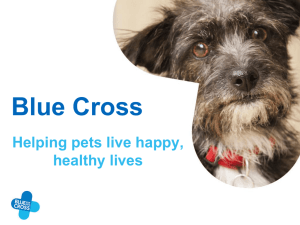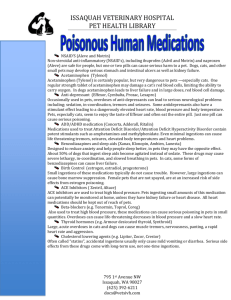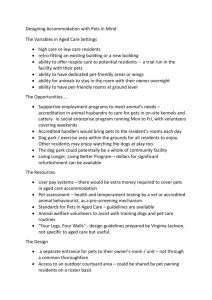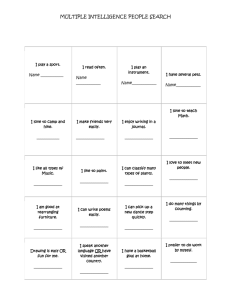Fall and Winter Dangers for Outdoor (Roaming) Cats and Dogs Fall
advertisement
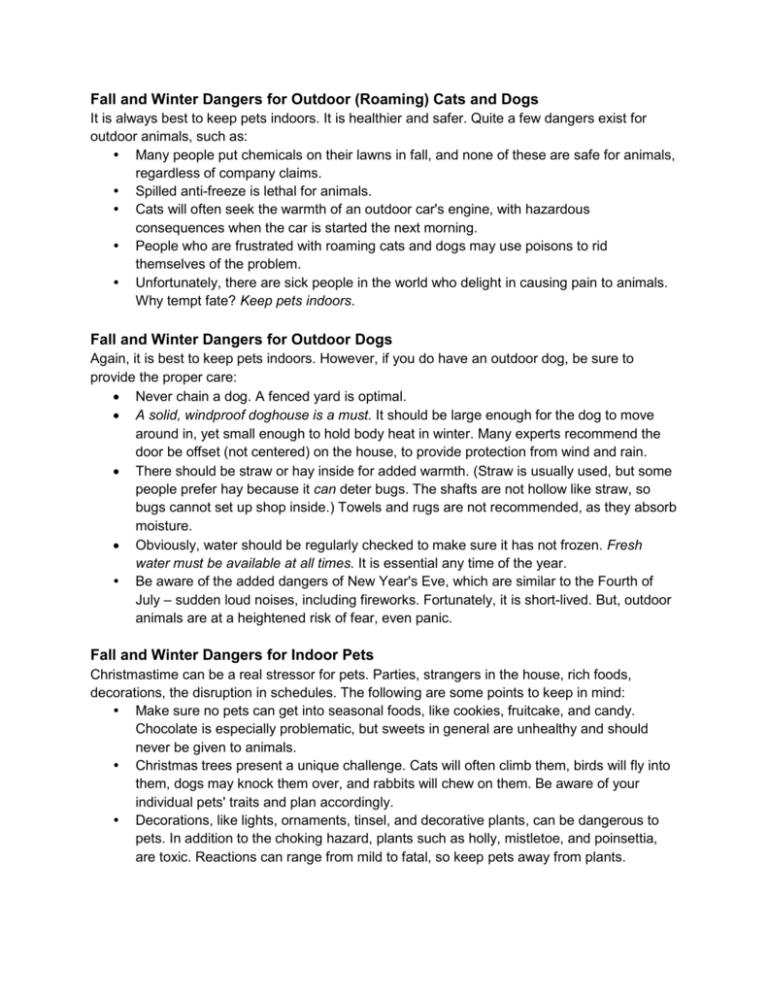
Fall and Winter Dangers for Outdoor (Roaming) Cats and Dogs It is always best to keep pets indoors. It is healthier and safer. Quite a few dangers exist for outdoor animals, such as: Many people put chemicals on their lawns in fall, and none of these are safe for animals, regardless of company claims. Spilled anti-freeze is lethal for animals. Cats will often seek the warmth of an outdoor car's engine, with hazardous consequences when the car is started the next morning. People who are frustrated with roaming cats and dogs may use poisons to rid themselves of the problem. Unfortunately, there are sick people in the world who delight in causing pain to animals. Why tempt fate? Keep pets indoors. Fall and Winter Dangers for Outdoor Dogs Again, it is best to keep pets indoors. However, if you do have an outdoor dog, be sure to provide the proper care: Never chain a dog. A fenced yard is optimal. A solid, windproof doghouse is a must. It should be large enough for the dog to move around in, yet small enough to hold body heat in winter. Many experts recommend the door be offset (not centered) on the house, to provide protection from wind and rain. There should be straw or hay inside for added warmth. (Straw is usually used, but some people prefer hay because it can deter bugs. The shafts are not hollow like straw, so bugs cannot set up shop inside.) Towels and rugs are not recommended, as they absorb moisture. Obviously, water should be regularly checked to make sure it has not frozen. Fresh water must be available at all times. It is essential any time of the year. Be aware of the added dangers of New Year's Eve, which are similar to the Fourth of July – sudden loud noises, including fireworks. Fortunately, it is short-lived. But, outdoor animals are at a heightened risk of fear, even panic. Fall and Winter Dangers for Indoor Pets Christmastime can be a real stressor for pets. Parties, strangers in the house, rich foods, decorations, the disruption in schedules. The following are some points to keep in mind: Make sure no pets can get into seasonal foods, like cookies, fruitcake, and candy. Chocolate is especially problematic, but sweets in general are unhealthy and should never be given to animals. Christmas trees present a unique challenge. Cats will often climb them, birds will fly into them, dogs may knock them over, and rabbits will chew on them. Be aware of your individual pets' traits and plan accordingly. Decorations, like lights, ornaments, tinsel, and decorative plants, can be dangerous to pets. In addition to the choking hazard, plants such as holly, mistletoe, and poinsettia, are toxic. Reactions can range from mild to fatal, so keep pets away from plants. Candles can be especially dangerous. If you have birds, whether or not they are allowed to fly freely, it is better to avoid traditional candles. Birds are susceptible to fumes and smoke. Opt for flameless (battery-operated) candles instead. Many pets are uncomfortable around strangers, particularly when they are coming into their homes. Dogs can view this as invading their territory. It can even lead to "fear biting." Be on the safe side. If you are having guests who are unfamiliar to your pets, keep them in a back room or the basement. (Your pets, not your guests!) Most birds do not like strangers, and they are agitated by loud and/or unfamiliar sounds. It's a good idea to put pet birds to sleep early on nights when you are having company. Cover their cages to keep out excess noise and stimulation. New Year's Eve is very similar to the Fourth of July – sudden loud noises, including fireworks, and excitement. Fortunately, it is short-lived. Still, the commotion can cause fear, so before the stroke of midnight, be sure pets are tucked safely away. Cats, in particular, should be out of the way of revelers. Most people open the front door to celebrate – the perfect opportunity for a skittish cat to escape. Interruptions in the day-to-day schedule can be hard both mentally and physically for animals. Try to stick to the usual routine as much as possible.
